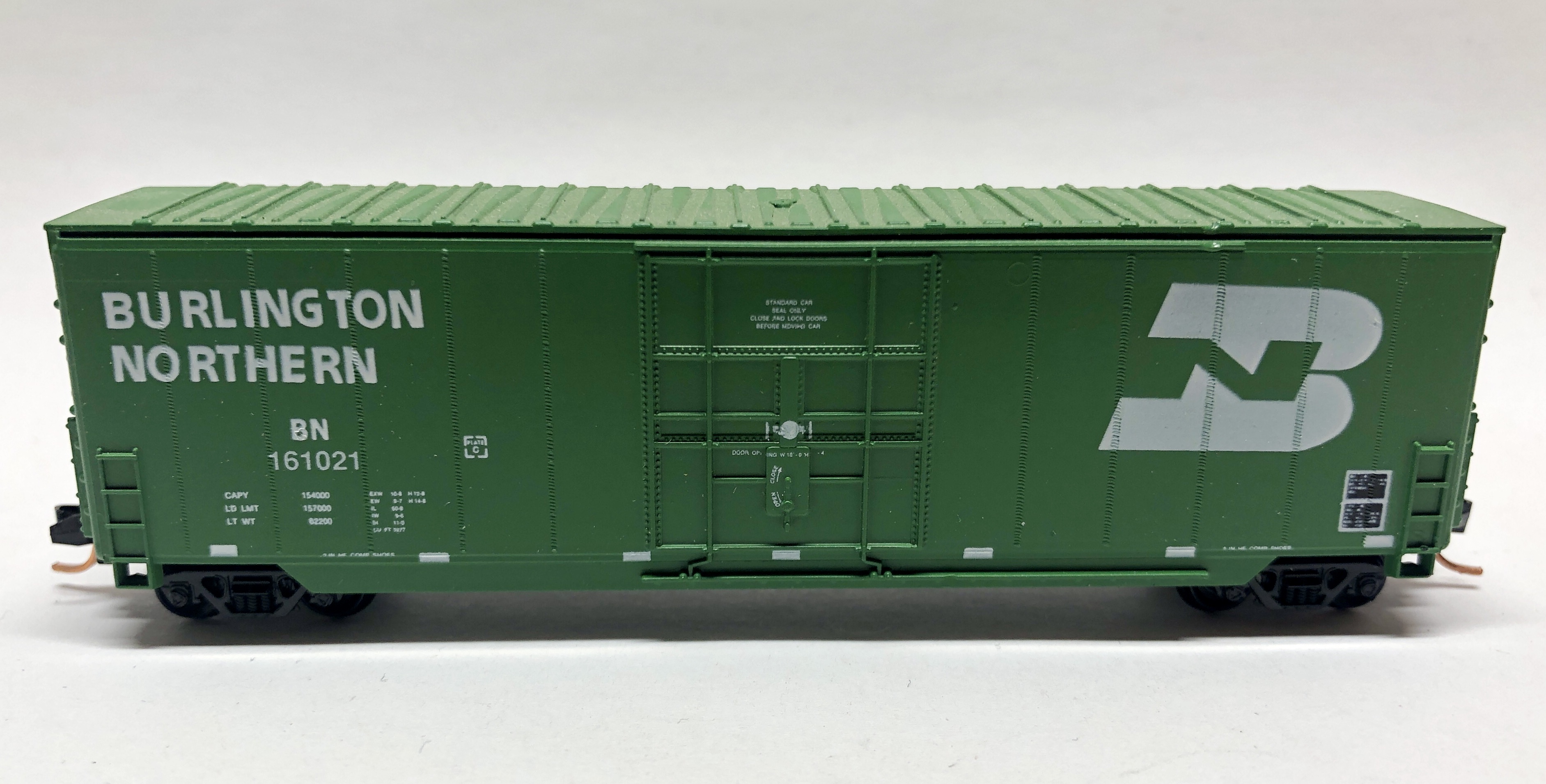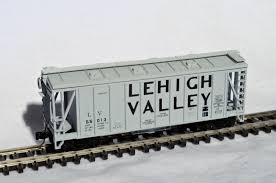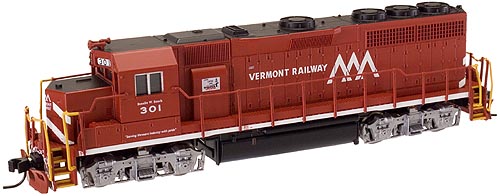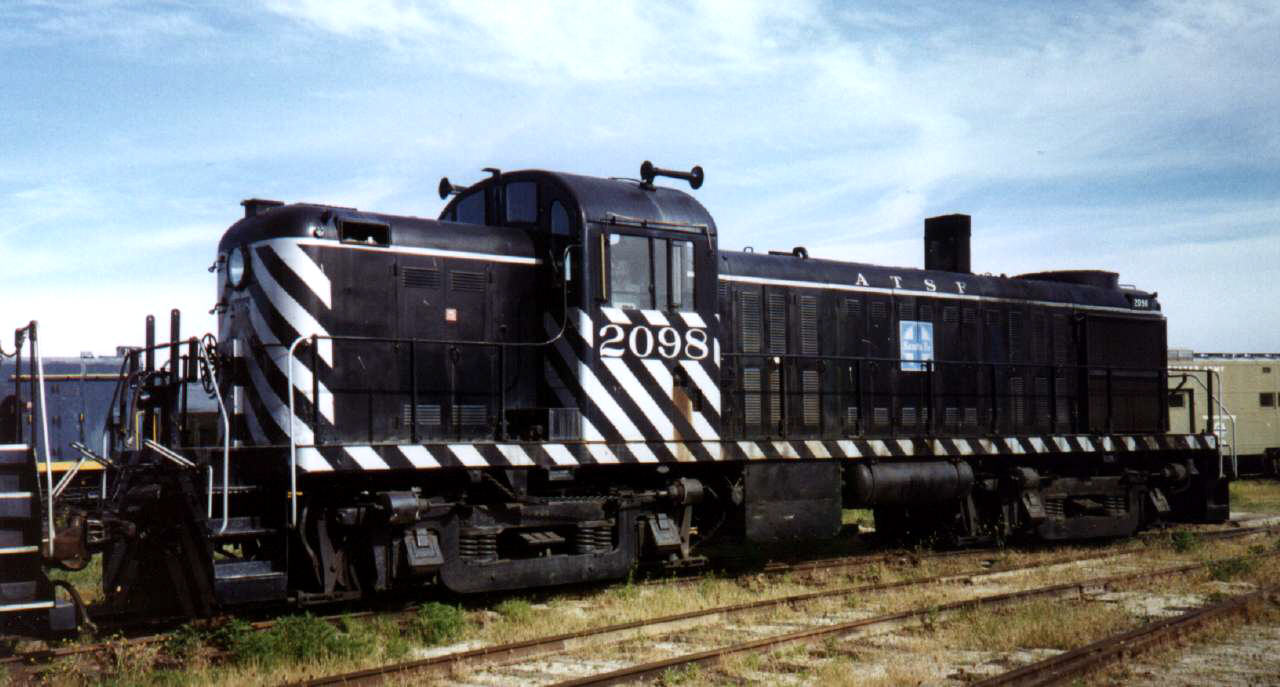Model Information: First released in 2007. Subsequent releases in 2008, 2011 and in 2012 (with MTL couplers). A fifth release was announced in 2012, but eventually cancelled due to insufficient reservations.
Re-run under Atlas brand in 2019 after Atlas purchased the tooling from Walthers.
Features:
Re-run under Atlas brand in 2019 after Atlas purchased the tooling from Walthers.
Features:
- split-frame, all-metal, DCC-Friendly chassis,
- 5-pole skew-wound "scale speed" motor, with dual flywheels,
- low-friction drive,
- bi-directional LED lighting,
- all-wheel drive and pickup (no traction tires),
- blackened, low-profile wheels,
- body-mounted Accumate couplers.
DCC Information: Contrary to the above review, due to the amount of effort required to install a decoder, we elected to classify this as DCC-Friendly.
Accepts the following plug-in decoders (non-sound), but requires a full disassembly of the locomotives, and proper isolation of the motor from the chassis with insulating tape:
- Digitrax DN163K2: 1 Amp N Scale Mobile Decoder for Kato N scale SD80/90MAC Series, RSC2, RS2. See installation tips on Digitrax website.
- TCS K2D4: N-scale drop-in decoder designed for Kato RS2/RSC2, SD80/SD90MAC and Life-Like/Walthers RS2, GP18 locomotives. See installation tips on TCS website.
The Atlas version of 2019 comes either with a factory-installed DCC decoder or in DC version.
Accepts the following plug-in decoders (non-sound), but requires a full disassembly of the locomotives, and proper isolation of the motor from the chassis with insulating tape:
- Digitrax DN163K2: 1 Amp N Scale Mobile Decoder for Kato N scale SD80/90MAC Series, RSC2, RS2. See installation tips on Digitrax website.
- TCS K2D4: N-scale drop-in decoder designed for Kato RS2/RSC2, SD80/SD90MAC and Life-Like/Walthers RS2, GP18 locomotives. See installation tips on TCS website.
The Atlas version of 2019 comes either with a factory-installed DCC decoder or in DC version.
Prototype History: The ALCO RS-2 is a 1,500–1,600 horsepower (1,100–1,200 kW) B-B road switcher diesel-electric locomotive built by the American Locomotive Company (ALCO) from 1946 to 1950. ALCO introduced the model after World War II as an improvement on the ALCO RS-1. The locomotive was one of several road switchers in a crowded market, including the Baldwin DRS-4-4-1500, EMD GP7, and FM H-15-44. ALCO discontinued the RS-2 in 1950 in favor of the ALCO RS-3. Several examples have been preserved.
383 locomotives were produced — 374 by the American Locomotive Company, and 9 by Montreal Locomotive Works in Canada. Eight of the ALCO RS-2s were exported to Canada. The RS-2 has a single, 12 cylinder, model 244B engine, developing 1,500 horsepower (1,100 kW). Thirty-one locomotives built by Alco between February and May 1950 with the 12 cylinder 244C 1,600 horsepower (1,200 kW) engine.
From Wikipedia
Read more on American-Rails.com
383 locomotives were produced — 374 by the American Locomotive Company, and 9 by Montreal Locomotive Works in Canada. Eight of the ALCO RS-2s were exported to Canada. The RS-2 has a single, 12 cylinder, model 244B engine, developing 1,500 horsepower (1,100 kW). Thirty-one locomotives built by Alco between February and May 1950 with the 12 cylinder 244C 1,600 horsepower (1,200 kW) engine.
From Wikipedia
Read more on American-Rails.com
Road Name History: The GB&W was the result of the 1896 reorganization of earlier companies connecting Green Bay, Wisconsin with the Mississippi River port of Winona, Minnesota. The line east from Green Bay to the car ferry port at Kewaunee was built as the affiliated Kewaunee Green Bay & Western. It wasn’t completely merged into GB&W until 1969. The 277 mile combined line bisected the state of Wisconsin. Railroad car ferries connected Kewaunee with the Ann Arbor, GTW, and C&O in Michigan’s lower peninsula. For a number of years, another subsidiary the Ahnapee & Western was operated as part of the GB&W but was sold to new owners in 1947.
Light rails and bridges put the GB&W about 20 years behind other railroads in steam technology. For instance, they were still receiving new 2-8-0’s in the late 20s. The biggest engines in the fleet were a half dozen light Mikados which arrived in 1937 and ’39.
In 1929, they established the Western Refrigerator Line to manage a 500 car fleet of reefers (presumably to serve the many packers of Green Bay.) Passenger service was always a low priority and ended entirely in 1941.
By 1950, they had completely dieselized, entirely with Alcos. For the second generation of diesels, GB&W concentrated on C424’s. Typically, there were 18-20 units on the roster at any one time. They would remain all-Alco to the end with first generation units set up to run long hood forward and second generation running short hood forward.
The bridge traffic created by the car ferry link to Michigan included high value auto parts. However, in the late 70’s, the car ferry traffic plummeted and GB&W began relying on paper industry traffic generated on line. In 1978 the line was purchased by Itel (yes, the per diem boxcar people.) Finally in 1993, the Green Bay & Western was merged into a subsidiary of Wisconsin Central.
Light rails and bridges put the GB&W about 20 years behind other railroads in steam technology. For instance, they were still receiving new 2-8-0’s in the late 20s. The biggest engines in the fleet were a half dozen light Mikados which arrived in 1937 and ’39.
In 1929, they established the Western Refrigerator Line to manage a 500 car fleet of reefers (presumably to serve the many packers of Green Bay.) Passenger service was always a low priority and ended entirely in 1941.
By 1950, they had completely dieselized, entirely with Alcos. For the second generation of diesels, GB&W concentrated on C424’s. Typically, there were 18-20 units on the roster at any one time. They would remain all-Alco to the end with first generation units set up to run long hood forward and second generation running short hood forward.
The bridge traffic created by the car ferry link to Michigan included high value auto parts. However, in the late 70’s, the car ferry traffic plummeted and GB&W began relying on paper industry traffic generated on line. In 1978 the line was purchased by Itel (yes, the per diem boxcar people.) Finally in 1993, the Green Bay & Western was merged into a subsidiary of Wisconsin Central.
Brand/Importer Information:  Life-Like Products LLC (now Life-Like Toy and Hobby division of Wm. K. Walthers) was a manufacturer of model railroad products and was based in Baltimore, Maryland.
Life-Like Products LLC (now Life-Like Toy and Hobby division of Wm. K. Walthers) was a manufacturer of model railroad products and was based in Baltimore, Maryland.
It was founded in the 1950s by a company that pioneered extruded foam ice chests under the Lifoam trademark. Because ice chests are a summer seasonal item, the company needed a way to keep the factory operating year round. As model railroading was becoming popular in the post-war years, they saw this as an opportunity and so manufactured extruded foam tunnels for model trains. Over the years, Life-Like expanded into other scenery items, finally manufacturing rolling stock beginning in the late 1960s. At some point in the early 1970s, Life-Like purchased Varney Inc. and began to produce the former Varney line as its own.
The Canadian distributor for Life-Like products, Canadian Hobbycraft, saw a missing segment in market for Canadian model prototypes, and started producing a few Canadian models that were later, with a few modifications, offered in the US market with US roadnames.
In 2005, the company, now known as Lifoam Industries, LLC, decided to concentrate on their core products of extruded foam and sold their model railroad operations to Wm. K. Walthers.
In June 2018, Atlas and Walthers announced to have reached an agreement under which all Walthers N scale rolling stock tooling, including the former Life-Like tooling, will be purchased by Atlas.
Read more on Wikipedia and The Train Collectors Association.

It was founded in the 1950s by a company that pioneered extruded foam ice chests under the Lifoam trademark. Because ice chests are a summer seasonal item, the company needed a way to keep the factory operating year round. As model railroading was becoming popular in the post-war years, they saw this as an opportunity and so manufactured extruded foam tunnels for model trains. Over the years, Life-Like expanded into other scenery items, finally manufacturing rolling stock beginning in the late 1960s. At some point in the early 1970s, Life-Like purchased Varney Inc. and began to produce the former Varney line as its own.
The Canadian distributor for Life-Like products, Canadian Hobbycraft, saw a missing segment in market for Canadian model prototypes, and started producing a few Canadian models that were later, with a few modifications, offered in the US market with US roadnames.
In 2005, the company, now known as Lifoam Industries, LLC, decided to concentrate on their core products of extruded foam and sold their model railroad operations to Wm. K. Walthers.
In June 2018, Atlas and Walthers announced to have reached an agreement under which all Walthers N scale rolling stock tooling, including the former Life-Like tooling, will be purchased by Atlas.
Read more on Wikipedia and The Train Collectors Association.
Item created by: Alain LM on 2018-08-10 05:52:33. Last edited by CNW400 on 2020-09-29 09:59:12
If you see errors or missing data in this entry, please feel free to log in and edit it. Anyone with a Gmail account can log in instantly.
If you see errors or missing data in this entry, please feel free to log in and edit it. Anyone with a Gmail account can log in instantly.










